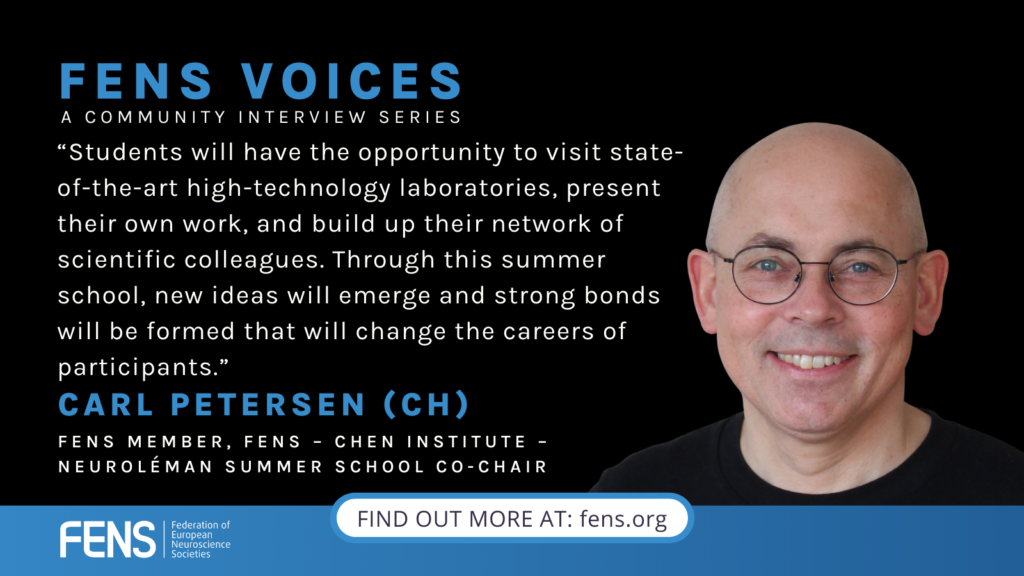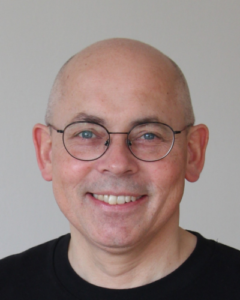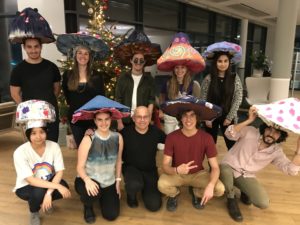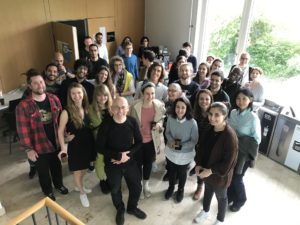
FENS Voices | Carl Petersen: Forging new ideas
30 June 2023
FENS News, Neuroscience News
FENS was delighted to chat with Dr Carl Petersen, co-chair (with Dr Brian McCabe) of the first FENS-Chen Institute-NeuroLéman Summer School on Motor Control, to find out more about this exciting new school. Dr Petersen initially studied physics as a bachelor student at the University of Oxford (1989-1992). During his PhD studies, under the supervision of Prof. Sir Michael Berridge at the University of Cambridge (1992-1996), he investigated cellular and molecular mechanisms of calcium signalling. Dr Petersen joined the Brain Mind Institute of the Faculty of Life Sciences at the Ecole Polytechnique Federale de Lausanne (EPFL) in 2003, setting up the Laboratory of Sensory Processing to investigate the functional operation of neuronal circuits in awake mice during quantified behaviour. Read the full interview below.

You will be co-chairing the first ever FENS-Chen Institute-NeuroLéman Summer School on Motor Control, alongside Dr Brian McCabe. What motivated you to get involved?
CP: Over the years, together with our NeuroLéman colleagues at the Universities of Lausanne and Geneva, we have previously run several summer schools, which have been enormously interesting and fun. In particular, I co-organised a very successful summer school series covering imaging methods for studying brain function supported jointly by FENS and IBRO in 2006, 2008, 2010 and 2012. I love the energy and passion of young dedicated scientists, and I am deeply committed to fostering their education through intense scientific exchanges at such summer schools. It is therefore with the greatest pleasure that I agreed to co-organise the first of a new series of FENS summer schools funded by the Chen Institute and run by the NeuroLéman Network. This year’s summer school will focus on motor control, which forms the basis of any behaviour, and thus fundamental to almost any study of systems neuroscience.
This school will take place between 2-8 July 2023 at the Swiss Federal Institute of Technology Lausanne (EPFL) in Switzerland. What are the benefits of this summer school and what do you have in store for us?
CP: This year’s FENS-Chen Institute-NeuroLéman Summer School will take place on the EPFL Lausanne Campus, which is spectacularly located by Lake Geneva and the snow-covered peaks of the Alps. Students will be housed in the campus and we will enjoy in-depth discussions about the neuronal mechanisms of motor control led by an international group of faculty members. We have selected 35 students from around the world to join us, and I look forward to exciting interactions and learning a lot. Students will have the opportunity to visit state-of-the-art high-technology laboratories, present their own work both through posters and short oral talks, discuss specific scientific challenges, and build up their network of scientific colleagues. Through this summer school, I envision that new ideas will emerge and strong bonds will be formed that will change the careers of many young scientists.
How was the NeuroLéman Network founded and what is its role within the European neuroscience community?
CP: There is a very strong neuroscience community around Lake Geneva, locally known as Lac Léman. Basic and clinical neuroscience at the Universities of Lausanne and Geneva, along with their associated hospitals, has been prominent well before the founding of the EPFL Brain Mind Institute. The added impetus of the founding of the Brain Mind Institute led to the establishment of a joint neuroscience doctoral school including common courses and an annual retreat at Les Diablerets. Further encouragement for local interactions and collaborations was provided by the Swiss National Science Foundation, who funded ‘Synapsy’, a so-called National Centre of Competence in Research. The strong sense of a local neuroscience community in the Lac Léman area, led Prof. Carmen Sandi to propose the establishment of the NeuroLéman Network, which now includes 119 principal investigators covering all aspects of basic and applied neuroscience. The NeuroLéman Network was established in 2018, and continues to develop an increasingly broad range of activities ranging from local workshops to international summer schools. The goal is to help highlight the immense potential of neuroscience research in this part of Switzerland, bringing additional strength to European neuroscience.

Talking about the noble goals of the NeuroLéman Network, you have an equally noble commitment to science. What attracted you to it and how did your passion develop into a career choice?
CP: For as long as I can remember, I have always been curious to learn what makes the world the way it is. I decided to study physics as an undergraduate because I was attracted to the idea that simple mathematical equations describing the laws of physics could be applied to provide mechanistic explanations for most of our observations about the world. At the time, I was particularly fascinated by quantum mechanics and Einstein’s theory of relativity. However, at the end of my undergraduate studies, I could not see obvious exciting research directions in theoretical physics. On the other hand, I had been introduced to membrane biophysics and electrophysiology, and it was clear to me that everywhere one looked in biology there were fascinating open questions, which could increasingly be addressed by new technologies. I, therefore, decided to turn my attention to understanding biophysical mechanisms in the life sciences, and I was lucky enough to have the opportunity to turn this passion into a career.
How did your physics training support your PhD thesis, which investigated cellular and molecular mechanisms of calcium signalling?
CP: Although I regret not having any formal training in life sciences, I do highly recommend Physics for undergraduate studies. Physics is the quantitative study of mechanisms, forces, and energy, and, as such, the principles of physics can directly be applied to the study of biological systems. Applying my knowledge of electricity and electronics gained from my Physics studies, during my PhD in Prof Sir Michael Berridge’s laboratory at the University of Cambridge, I greatly enjoyed making voltage-clamp recordings of membrane currents and thinking about the underlying stochastic gating of ion channels as they open and close. Applying my knowledge of diffusion from Physics, as I started my PhD studies, I also immediately began quantitative modelling of intracellular calcium signalling, which in many cells is supported by regenerative calcium release from intracellular calcium stores forming propagating waves, in some respects reminiscent of the action potential.
Do you recall the first time you heard the term “neuroscience”?
CP: I must admit I don’t remember when I first heard the term ”neuroscience”, but like most people, I suppose, I had been fascinated from early childhood about how we perceive and learn about the world around us, and I had also witnessed the devastating impact of various brain disorders. However, I considered the complexity of the brain to be beyond understanding, and, as a PhD student, I preferred initially to study simpler aspects of cell biology and biophysics. However, in the course of my PhD studies, I became increasingly aware of the key role of calcium signals, not just in the control of the membrane fusion events underlying synaptic transmission, but also in the control of synaptic plasticity. As I began to read and learn about long-term potentiation and depression of synaptic transmission, I realised how far neuroscientists had come towards uncovering potential mechanisms for learning, and I found this incredibly exciting. Perhaps there was hope for some simple fundamental principles, like those described in the Laws of Physics, to determine the complex workings of the brain. As I completed my PhD, I therefore decided to turn my attention to investigating synaptic plasticity.

When did you decide to fully dedicate yourself to brain research?
CP: I feel incredibly lucky to have trained as a postdoc in two remarkable laboratories. I was struck by the elegance and power of Prof. Roger Nicoll’s simple experimental approach to investigating the molecular mechanisms underlying long-term potentiation in hippocampal slices in vitro. There was an enormous buzz of excitement in the laboratory and every moment was spent intensely discussing the latest experiments within the laboratory, as well as considering results and publications of competing laboratories. My favourite discovery from my time at UCSF was the observation of a step-like, apparently all-or-none, increase in the strength of individual synapses as they underwent potentiation induced by pairing postsynaptic depolarisation with so-called minimal stimulation of axonal fibres. In order to directly study communication between neurons, I next moved to Prof. Bert Sakmann’s laboratory at the Max Planck Institute for Medical Research in Heidelberg, where they had recently begun making simultaneous recordings from multiple neurons in brain slices in vitro. There I began mapping synaptic connectivity in the primary somatosensory neocortex, and began studying neuronal network function. I was greatly inspired by the long-term vision of Prof. Bert Sakmann to bridge the study of synaptic communication with sensory processing, and this provided me with the basic theme of my life’s work. I think the most exciting moment during my second postdoctoral period in the Sakmann laboratory was when we obtained the first in vivo dual whole-cell recordings of membrane potential finding an unexpectedly high-degree of synchrony. How could the brain process information under such circumstances of high membrane potential synchrony and high trial-to-trial variability? These burning questions remain largely unsolved, and thus remain a major focus of my ongoing research.
Why did you choose to join the Brain Mind Institute of the Faculty of Life Sciences at the Ecole Polytechnique Federale de Lausanne (EPFL) in 2003? What is the origin story of the Laboratory of Sensory Processing?
CP: After my postdoctoral periods in San Francisco and Heidelberg, I felt that I had learned enough neuroscience to launch my own laboratory studying neuronal circuits underlying sensory processing in awake head-restrained mice. At the time, there was a great deal of excitement in the European neuroscience community about the founding of a new Faculty of Life Sciences at the EPFL, with neuroscience at centre stage with Prof. Henry Markram as the Director of the new Brain Mind Institute. The opportunity to help shape a new institute associated with considerable resources and ambitious goals was extremely attractive to me. I was excited about the mix of experimental and computational neuroscience laboratories that were proposed to be established on a campus renowned for advanced technology. I was therefore delighted to accept a position as an assistant tenure-track professor at EPFL.
Which areas of research interest you most and why? How can you obtain a causal and mechanistic understanding of simple forms of sensory perception and associative learning?
CP: My initial goal as I began my new laboratory was to track the interactions between various neurons in the somatosensory cortex to investigate whisker sensory processing in awake behaving mice. Mice actively move their whiskers to touch objects in the space around their snouts, and this form of active sensing formed the focus of early work in my new lab. However, we rapidly discovered that sensory signals could be recorded in a variety of downstream brain areas, and thus began our current efforts to explore brain-wide whisker-related sensory processing. We also rapidly discovered that sensory processing depended strongly upon brain states, and with that observation we gradually turned our attention to investigating sensory perception, here defined as the subjective percept of a sensory stimulus, rather than just the evoked neuronal activity. Studying sensory perception necessitates the behavioural report of subjective percepts, and thus we began training mice to carry out the simple task of licking a reward spout in response to whisker stimulation. We thus turned our attention to licking motor control and how reward-based learning can forge a link between whisker sensation and a goal-directed motor output. These topics are of broad interest to many circuit and systems neuroscientists, and I imagine attempting to uncover the neuronal mechanisms will keep me busy for the rest of my days. Through applying behavioural, electrophysiological, optical, molecular and computational methods, my hope is that we will obtain sufficiently detailed information about cell-type-specific neuronal activity and plasticity, that we will be able to causally link changes in synaptically-connected neuronal networks to learning.
About the FENS – Chen Institute – NeuroLéman Summer School on “Motor control: from thought to action”
The new FENS – Chen Institute – NeuroLéman Summer School Series on Brain Dynamics in Health and Disease will explore cutting-edge technologies for basic and clinical neuroscience, in order to develop novel concepts and new research techniques to address the challenges of investigating brain function and dysfunction.
The first FENS – Chen Institute – NeuroLéman Summer School will focus on integrating technology in fundamental and clinical neuroscience and understanding how the brain organises and controls motor function. Physiological and pathological aspects of motor neuroscience will be investigated through the lens of the latest technologies in the field. The summer school is designed to allow the free exchange of technological know-how and ideas with local and international neuroscientists in a beautiful alpine lake environment.
About FENS Schools
With a mission to support education and training of early-career neuroscientists, FENS offers a recurrent programme of two high-level neuroscience schools: the “FENS-Chen Institute-NeuroLéman Summer School” and the “FENS-Hertie Winter School” (in collaboration with the Hertie Foundation). Run within an intimate setting by leading scientists around novel concepts in neuroscience, they allow informal interaction between students and faculty, and provide participants with a broad perspective on a dedicated field.
About the Tianqiao and Chrissy Chen Institute
The Tianqiao and Chrissy Chen Institute (TCCI®) was created in 2016 by Tianqiao Chen and his wife Chrissy Luo, the founders of Shanda Group, with a US $1 billion commitment to help advance brain research around the world. The organisation’s vision is to improve the human experience by understanding how our brains perceive, learn, and interact with the world. TCCI® created the Tianqiao and Chrissy Chen Institute for Neuroscience at Caltech in 2016 and in 2017, the Chens created the Tianqiao Chen Institute for Translational Research, a partnership with the Zhou Liangfu Foundation, Huashan Hospital and Shanghai Mental Health Center. In October 2020, TCCI opened the Chen Frontier Lab for Applied Neurotechnology and in July 2021 announced the Chen Frontier Lab for AI and Mental Health.
About the NeuroLéman Network
The NeuroLéman Network is a coordination body for neuroscience research and education in the Swiss Lémanic (Lake Geneva) area. The network encompasses more than 100 laboratories across three Institutions: EPFL – The Swiss Federal Institute for Technology Lausanne, the University of Geneva and the
University of Lausanne. The NeuroLéman Network engages its members in neuroscience education programs at the Bachelor, Master and Postgraduate levels plus research training programs in basic and clinical neuroscience, in addition to neuroengineering and neuroprosthetics.
About the Federation of European Neuroscience Societies (FENS)
Founded in 1998, the Federation of European Neuroscience Societies is the main organisation for neuroscience in Europe. It currently represents 44 national and single-discipline neuroscience societies across 33 European countries and more than 22,000 member scientists. Discover FENS and subscribe to our biweekly News Alert, with information on our latest calls and activities.